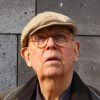Claes Oldenburg

Claes Oldenburg
Claes Oldenburgis an American sculptor, best known for his public art installations typically featuring very large replicas of everyday objects. Another theme in his work is soft sculpture versions of everyday objects. Many of his works were made in collaboration with his wife, Coosje van Bruggen. Van Bruggen died in 2009 after 32 years of marriage. Oldenburg lives and works in New York...
NationalitySwedish
ProfessionSculptor
Date of Birth28 January 1929
CityStockholm, Sweden
CountrySweden
I just started to do my own thing for about a year and a half, and I worked in the evening selling phonograph records. Then I said to myself, "I'm afraid I have to go to New York after all."
I was very happy to be living in New York at that time, more than in the present time. Now it's all commerce.
Andy [Warhol] was on the scene, but he wasn't an artist at first; he was more an illustrator. He was always surrounded by about ten people who worshipped him. He'd go to a party and they would all come along. But he was drawing shoes and that sort of thing.
My work doesn't have the same rules as, say, Andy [Warhol]'s work. But it's gathered together for the simple reason that we all worked with the images and objects around us.
The thing about the ray gun is, you pick up anything you see on the street that's the shape of a gun.
I always knew America was all about guns. You go to the movies as a kid, everybody's got a gun.
The sexual is part of everything, and it's highly formalized. I hadn't done figure for a long time. And I thought to myself, "Why not the erotic figure?"
There's always been a potential erotic possibility with objects.
The end of the '60s was a terrible time. I was in Los Angeles then, and I remember the night someone ran into the studio and told us about the Manson murders. Then suddenly something happened, the '60s disappeared. The '70s were completely different.
Of course, the '60s was a study in decadence. Everything just got worse and worse, and at the end of the '60s, everything was so horrible that people were killing each other.
Duchamp is known for calling a thing art, rather than making it. A lot of that is picked up in pop art, too.
I'm always careful to say that I changed everything I found.
Mine was not pop art. I maybe started with a subject, but I changed the subject.
I started to draw buildings. I called them Proposed Colossal Monuments - they weren't for real, not for actual building. It was more a critique of architecture.